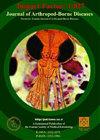伊朗一个人畜共患性皮肤利什曼病流行区的 Papatasi Phlebotomus(Diptera: Psychodidae)对滴滴涕和溴氰菊酯的敏感性
IF 0.6
4区 医学
Q4 PARASITOLOGY
引用次数: 0
摘要
背景:在伊朗,Phlebotomus papatasi(双翅目:Psychodidae)是人畜共患皮肤利什曼病(ZCL)的主要病媒。杀虫剂的非标准使用,特别是在农业中的使用,间接导致了抗药性的产生,从而威胁到 ZCL 流行地区的控制措施。截至 2023 年,旧大陆已经有多份 Ph. papatasi 产生抗药性的报告。本研究的目的是测量伊斯法罕 ZCL 流行中心的 Papatasi 沙蝇对滴滴涕和溴氰菊酯杀虫剂的致死时间(LT50 和 LT90)。研究方法在 Borkhar 采集沙蝇,并使用世界卫生组织成蚊测试工具对滴滴涕 4% 和溴氰菊酯 0.0002% 进行测试。在滴滴涕和溴氰菊酯的暴露时间间隔为 225 秒、450 秒、900 秒、1800 秒和 3600 秒时,记录沙蝇的存活率,并让它们恢复 24 小时。然后使用 probit 软件对 LT50 和 LT90 进行分析。用形态学钥匙对Phlebotomus papatasi进行鉴定,其他沙蝇种类不在分析之列。结果对雌性 Papatasi 沙蝇的杀虫结果表明,在接触 4%的滴滴涕和 0.0002%的溴氰菊酯时,死亡率为 100%。滴滴涕 4% 的半衰期(LT50)和半衰期(LT90)分别为 19.32 分钟和 22.74 分钟,溴氰菊酯 0.0002% 的半衰期(LT50)和半衰期(LT90)分别为 39.92 分钟和 51.33 分钟。结论研究结果表明,Ph. papatasi 对滴滴涕和溴氰菊酯仍然易感。这些数据为针对 ZCL 主要病媒实施有效的控制策略提供了宝贵的知识,并有助于管理该地区的杀虫剂抗药性。本文章由计算机程序翻译,如有差异,请以英文原文为准。
Susceptibility of Phlebotomus papatasi (Diptera: Psychodidae) against DDT and Deltamethrin in an Endemic Focus of Zoonotic Cutaneous Leishmaniasis in Iran
Background: Phlebotomus papatasi (Diptera: Psychodidae) is the main vector of zoonotic cutaneous leishmaniasis (ZCL) in Iran. The nonstandard use of pesticides against pests, particularly in agriculture, indirectly has caused the development of resistance and, consequently, the threat of control measures in ZCL endemic areas. Up to 2023, several reports of resistance in Ph. papatasi have been declared in the Old World. The purpose of this study was to measure the lethal time (LT50 and LT90) of Ph. papatasi sand flies in the ZCL endemic center of Esfahan to DDT and deltamethrin insecticides.
Methods: Sand flies were collected in Borkhar and were tested using WHO adult mosquito test kit against DDT 4% and deltamethrin 0.0002%. The sand fly’s survival was recorded during exposure time in 225, 450|, 900, 1800, and 3600-seconds’ intervals for DDT and Deltamethrin and they were allowed to recover for 24 hours. Then LT50 and LT90 were analyzed using probit software. Phlebotomus papatasi were identified using morphological keys and other sand flies’ species were excluded from the analysis.
Results: The insecticide against female Ph. papatasi revealed hundred percent mortality when exposed to DDT 4% and deltamethrin 0.0002%. The LT50 and LT90 were 19.32 and 22.74 minutes for DDT 4% and 39.92 and 51.33 minutes for deltamethrin 0.0002% respectively.
Conclusion: Results of this study revealed that Ph. papatasi is still susceptible to DDT and deltamethrin. This data provides valuable knowledge to implement effective control strategies against ZCL main vector and help to manage insecticide resistance in the region.
求助全文
通过发布文献求助,成功后即可免费获取论文全文。
去求助
来源期刊

Journal of Arthropod-Borne Diseases
PUBLIC, ENVIRONMENTAL & OCCUPATIONAL HEALTH-PARASITOLOGY
CiteScore
2.00
自引率
11.10%
发文量
17
审稿时长
8 weeks
期刊介绍:
The journal publishes original research paper, short communication, scientific note, case report, letter to the editor, and review article in English. The scope of papers comprises all aspects of arthropod borne diseases including:
● Systematics
● Vector ecology
● Epidemiology
● Immunology
● Parasitology
● Molecular biology
● Genetics
● Population dynamics
● Toxicology
● Vector control
● Diagnosis and treatment and other related subjects.
 求助内容:
求助内容: 应助结果提醒方式:
应助结果提醒方式:


